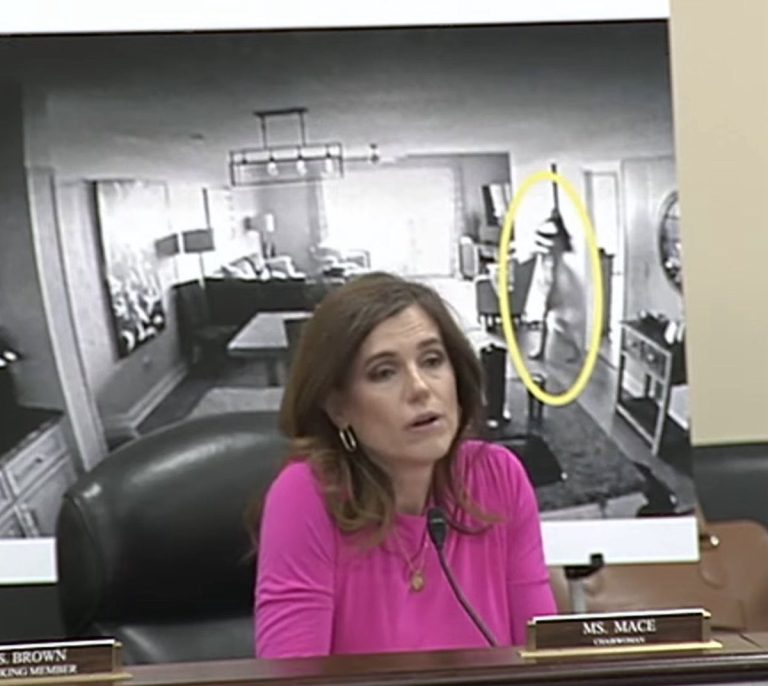In an intense moment on Capitol Hill, Congresswoman Nancy Mace made headlines after displaying a censored nude photo of herself during a House Oversight Committee hearing. The hearing, focused on surveillance in private spaces, took a personal turn as Mace revealed that the image was captured without her consent by her former fiancé, Patrick Bryant. Her move was a bold and emotionally charged effort to draw attention to a growing crisis of non-consensual surveillance and exploitation. Nancy Mace’s decision to bring her traumas into the public sphere has ignited fierce national debate.
A Bold Personal Statement
Nancy Mace’s decision to show a censored nude image of herself during the hearing was a shocking visual statement, but she made it clear that the move was rooted in advocacy, not provocation. She told the committee that the photo had been secretly taken by Patrick Bryant using hidden surveillance, part of what she claimed was a pattern of predatory behavior. According to Mace, the image was just one piece of evidence in a broader campaign of digital abuse. Her goal: to highlight how rampant and unregulated such invasions of privacy have become, even among public figures.
What makes Mace’s stance so noteworthy is her willingness to put herself on the line. In a political climate often built on controlled messaging, she dropped the façade and presented raw vulnerability. Nancy Mace alleged that Bryant had stored years of secretly obtained footage from multiple women, turning private lives into hidden archives. This, she argued, is exactly why stronger laws are needed for anyone who could be silently targeted in their own home. Her words were pointed and personal.
In her testimony, Mace called for comprehensive reforms that would penalize the creation and distribution of non-consensual imagery with criminal seriousness. She urged lawmakers to see beyond the politics of the moment and recognize the urgent need to close legal gaps around digital voyeurism and abuse. Nancy Mace used her platform not just to recount trauma, but to demand accountability. Her story has amplified a conversation that too often remains buried in legal technicalities or dismissed as rare and unfortunate. For Mace, it was about forcing change through discomfort.
Public Reaction and Legal Ripples
The public reaction to Nancy Mace’s revelation has been explosive. Supporters have praised her for her bravery and transparency, arguing that her actions give voice to countless victims who suffer in silence. Detractors, however, have questioned the appropriateness of such a personal display in a government setting. That divide has sparked an urgent question: How far is too far when trying to provoke legal and cultural change? Mace, meanwhile, remains unapologetic, framing the decision as a necessary step to jolt policymakers into action.
Her allegations against Patrick Bryant include some of the most serious accusations a public figure has levied in recent memory, ranging from rape to sex trafficking. Bryant has denied all claims, calling them malicious and false. As investigations unfold, legal experts are closely watching whether this highly public airing will translate into charges or policy changes. Nancy Mace, by stepping into such a charged spotlight, is now not only a lawmaker but a central figure in an unfolding legal drama that could redefine surveillance laws.
Beyond Capitol Hill, activists and legal advocates are seizing on the moment to push for updated privacy legislation. With rapid advances in hidden camera technology, the line between safety and surveillance has blurred. Nancy Mace’s situation underscores how current laws are failing to keep up with that technological reality. Some groups are already organizing behind her, calling for digital consent laws and broader protections against voyeuristic abuse. Her personal story has given their arguments a human face, one that is impossible to ignore in a news cycle that moves quickly past less visceral issues.
Conclusion
Nancy Mace turned an intensely personal violation into a platform for national policy conversation, and possibly, transformation. By taking a bold stand, she forced the public to confront the ugly realities of non-consensual surveillance and the legal blind spots that allow it to continue. Her story has moved beyond headlines and into the heart of the privacy debate. Whether or not her actions lead to direct legislative change, one thing is certain: Nancy Mace has reframed the conversation in ways that will not be easily forgotten. Her courage may very well spark the legal clarity victims have long needed.








